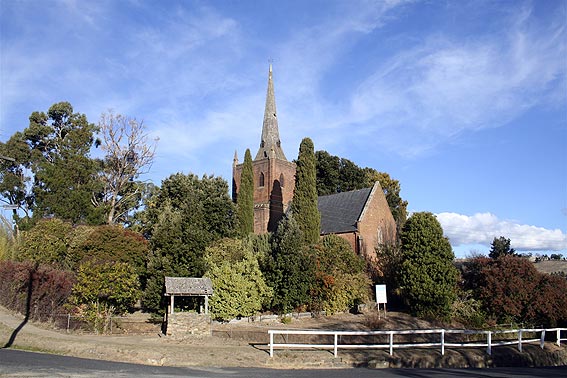
[Photo: Trevor Bunning (March 2019)]

[Photo: Trevor Bunning (March 2019)]
Historical and Technical Documentation by Kelvin Hastie, John Stiller and others
© OHTA 1990, 2010, 2019 (last updated March 2019)
The foundation stone of St Paul's Church was laid in January 1845.1 Constructed in brick, the building was designed by Edmund Blacket in a simple Decorated Gothic idiom and is said to have been derived from a medieval church at Cassington, outside Oxford. The building was first used for worship in 1848 and the building consecrated in the following year. In 1874-75, the tower and shingled wooden spire placed above the chancel, of somewhat naïve quality, were added. This is the second oldest church west of the Blue Mountains, after Holy Trinity, Kelso. St Paul's is a highly picturesque building placed high above the town. The interior has whitewashed brick walls, consisting of a nave, chancel placed beneath the tower and a sanctuary.2

St Paul's Anglican Church, Carcoar
[Photo: Trevor Bunning (March 2019)]
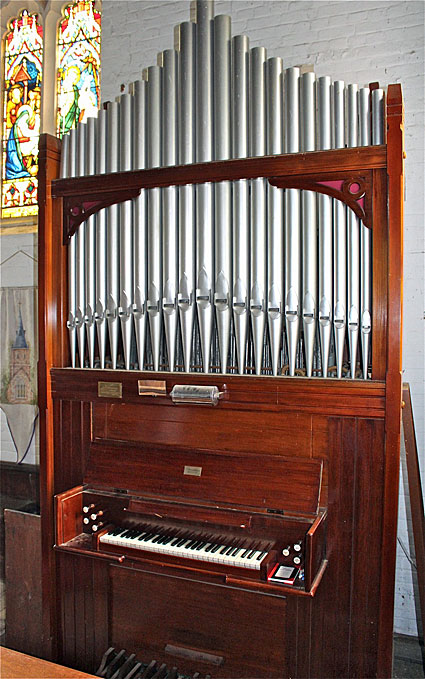
The Richardson organ in St Paul's Anglican Church, Carcoar
[Photo: Trevor Bunning (March 2019)]
In 1984 John Stiller documented the small Richardson organ in this church as part of his work as OHTA Research Officer. The following historical notes were made:
This organ was built by C. Richardson, Sydney, and installed in this church as a memorial to Susanna Emily Henn-Gennys who died on 29th January, 1897. It seems most likely that this organ was built around 1900, and was originally installed at the front of the church (in the choir). At some later stage, it was moved to its present position in the corner of the west and north walls.
Various alterations which have been made to this organ include:
1. The removal of the hand-blowing apparatus;
2. The disconnection of the stop action for the Octave coupler;
3. The addition of the Flute d'Amor (on a clamp)...
This instrument is an interesting example of a small organ built by Charles Richardson, featuring a very full and powerful Open Diapason, a lighter Principal, a neutral Stopd. Diapason with a prominent chiff, and a very delicate Flute d'Amor of Dulciana quality. It serves as an excellent indication of Richardson's voicing capabilities and forms an integral part of the heritage to be found in the historic town of Carcoar. Its preservation should be given equal importance with the numerous fine buildings to be found in this picturesque town. A faithful renovation would reveal many latent qualities present in this fine little organ...
The historic value of this organ is highlighted by:
1. Retention of all original pipework and the cone-tuning of the internal open metal pipes;
2. The preservation of the original case...
3. The presence of many original console components, such as stop heads, stop labels, keyboard, keyboard cheeks, a concave and parallel pedalboard, nameplate of builder, and organ bench.
4. The retention of the original double-rise bellows;
5. The preservation of the original mechanical key and stop actions.
The organ is now [1984] in poor playing condition and a full restoration would be desirable.3

Console, including pedalboard, of the Richardson organ
[Photo: Trevor Bunning (May 2006)]
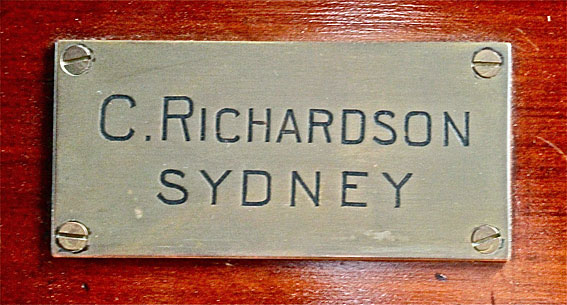
Richardson's nameplate on the organ
[Photo: Trevor Bunning (March 2019)]

Casework of the Richardson organ
[Photo: Trevor Bunning (March 2019)]
In 2001, the organ was restored by Roger H. Pogson Pty Ltd of Orange. During the work the following was completed:
1. The supply of a new Ventus blower, located outside the building
2. The releathering of the bellows
3. The repair and resealing of all trunks and conveyances, including the front block assembly
4. The restoration of the chests, including releathering of pallets
5. The repair of all pipework, with extensive work carried out on the Flute d'Amor to facilitate better speech (this involved transposition of pipework by a semitone)
6. The repair and re-alignment of the action
7. The repolishing of the casework combined with the straightening out and repainting in silver (as original) of the front pipes
8. Repair of the console area, with key surfaces cleaned and pedals resurfaced and refelted.4
The specification is:
| Manual (unenclosed) Open Diapason Stopd. Diapason Treble Stopd. Diapason Flute d'Amor Principal Couplers Octave Coupler Pedal Coupler |
8 ft* [8]* 8 ft+ [8]* 4 ft |
* From co
+ C-B
Mechanical action
Compass 56/25
Number of pipes = 200
Pitch a = 453.2 at 19oC
Wind pressure [1984] = 70mm.5
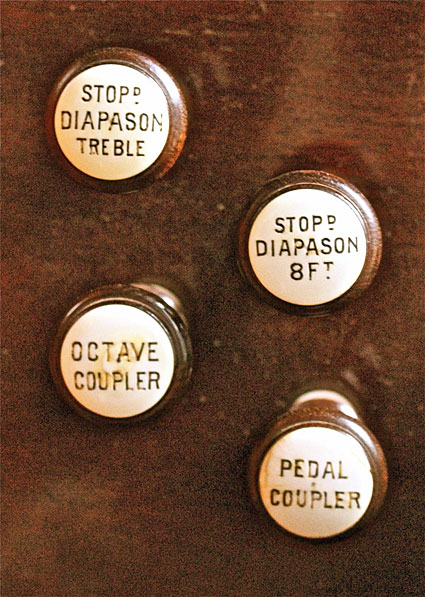
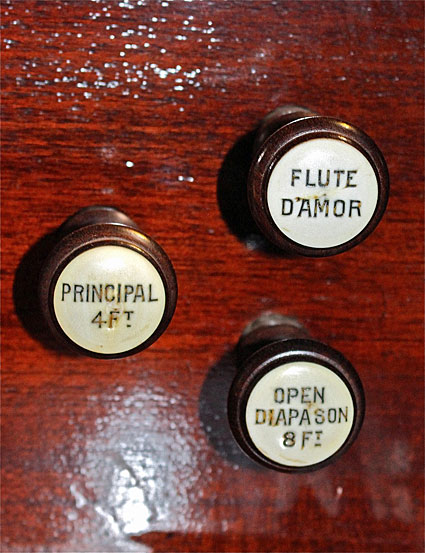
Stop Jambs of the Richardson organ
[Photos: Trevor Bunning (March 2019)]
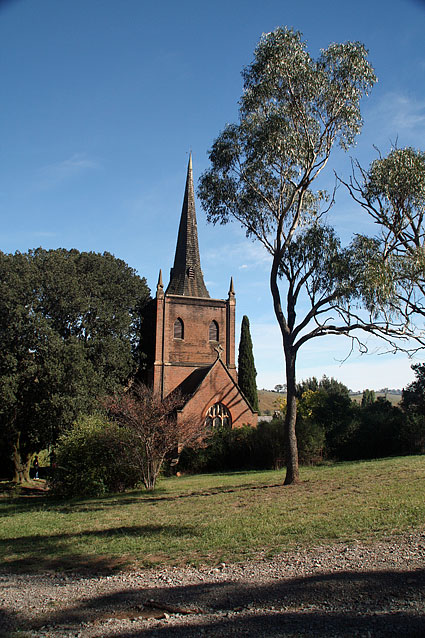
[Photo: Simon Colvin (April 2010)]

[Photo: Trevor Bunning (May 2006)]
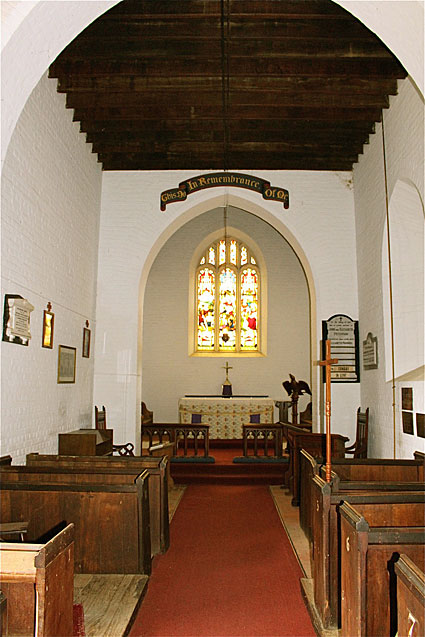
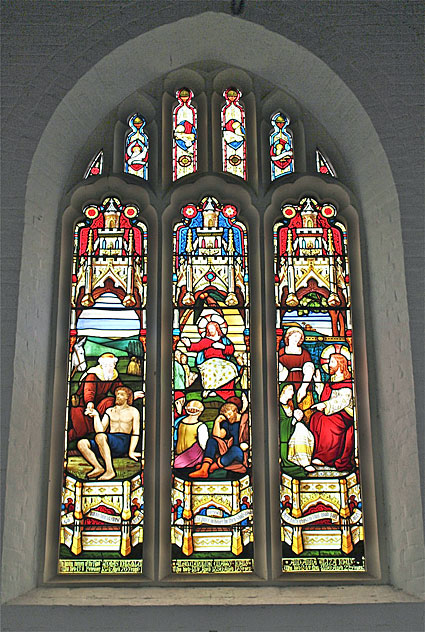
[Photos: Trevor Bunning (March 2019)]
_________________________________________________________________
1 The Sydney Morning Herald (9 May 1845), p. 3.
2 Information provided by John Maidment, including material from: http://www.blaneyanglican.info/html/carcour_history.html - accessed 18 January 2010.
3 John Stiller, St Paul's Anglican Church, Carcour, NSW. Documentation of Pipe Organ built c.1900 by Charles Richardson (Organ Historical Trust of Australia, 13 March 1984).
4 Kelvin Hastie, "Restorations – St Paul's Anglican Church, Carcoar, NSW," OHTA News, vol. 25, no. 1 (January 2001), p. 7.
5 Specification from John Stiller, op. cit.